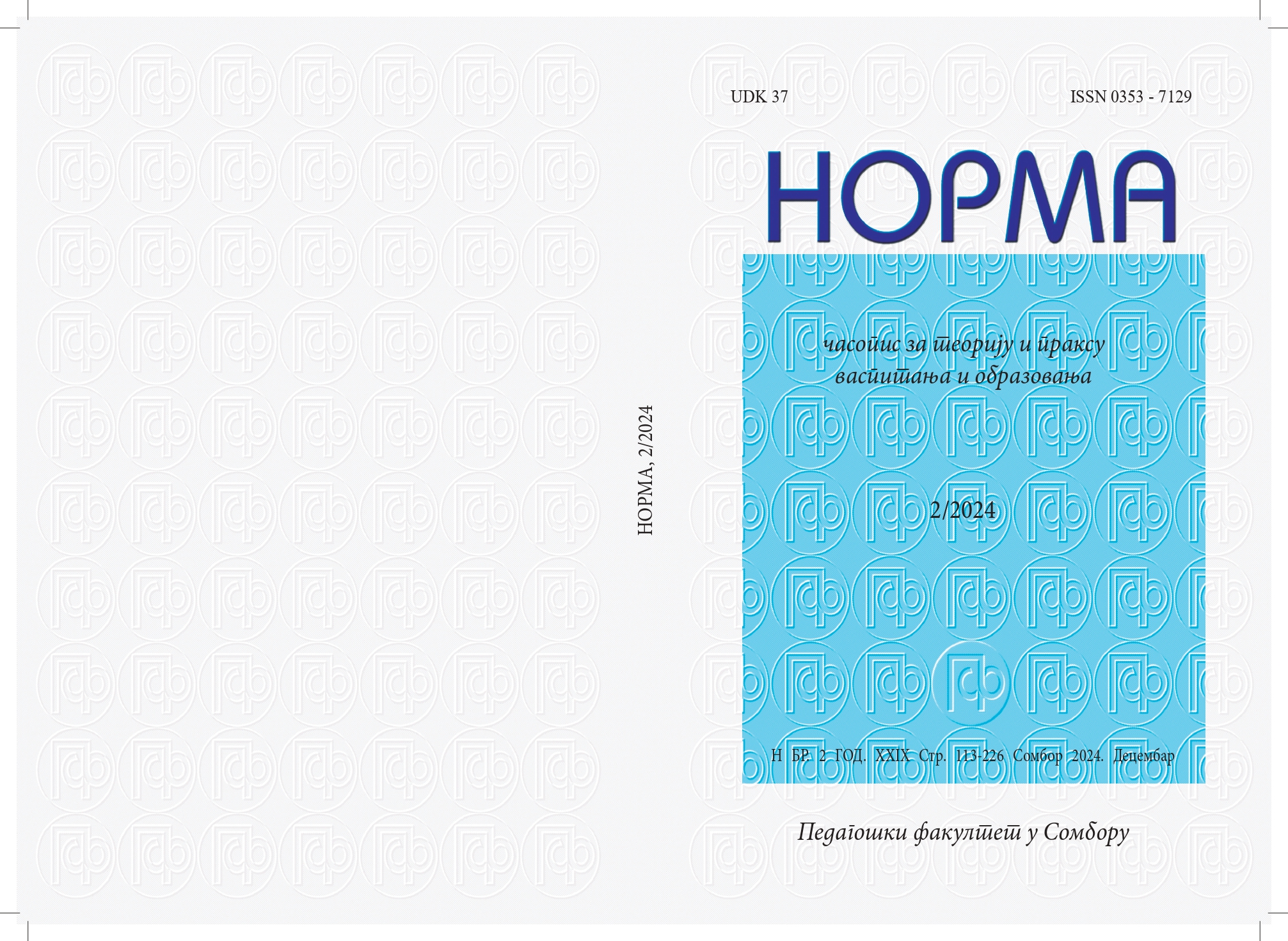Преглед досадашњих истраживања о учењу и поучавању наставних садржаја о смешама и растворима
Sažetak
Резиме: У раду су анализирана досадашња истраживања о учењу и поучавању наставних садржаја о смешама и растворима чији је циљ био унапређење како самог наставног процеса тако и ученичке мотивације и постигнућа. Посебна пажња посвећена је анализи развоја појмова о смешама и растворима, ефектима концептуалне промене након наставних интервенција, као и могућностима почетног поучавања и учења ових садржаја са аспекта честичне природе супстанце. Многи аутори указују на распрострањеност и укорењеност низа алтернативних ученичких идеја, као и на наставне стратегије које би омогућиле њихову замену научним концептима. У другој групи истраживања су она у којима се анализирају домети различитих наставних приступа при обради садржаја о смешама и растворима. Већина налаза указује на значај развоја ефикасних стратегија у циљу унапређења како когнитивних способности и различитих вештина ученика, тако и њихове мотивисаности и ставова према настави природних наука.
Кључне речи: смеше и раствори, развој појмова, алтернативне идеје, наставни приступи, природне науке
Reference
Правилник о програму наставе и учења за други разред основног образовања и васпитања (2018), Службени гласник РС, Просветни гласник. Бр. 16.
Правилник о програму наставе и учења за трећи разред основног образовања и васпитања (2019), Службени гласник РС, Просветни гласник. Бр. 5.
Правилник о програму наставе и учења за четврти разред основног образовања и васпитања (2019), Службени гласник РС, Просветни гласник. Бр. 11.
Awan, A. S., Khan, T. M., Mohsin, M. N., & Doger, A. H. (2011). Students’ Misconceptions in learning basic concept ‘composition of matter’ in chemistry. International Journal of Applied Science and Technology, 1(4), 161-167.
Cahyanto, M.A.S., Ashadi, H. & Saputro, S. (2019). Analysis of students’ misconception based on the use of learning objectives in classification of materials and their properties. Journal of Physics Conference Series, 13(1), 1-6.
Çalık, M. & Ayas, A. (2005). A cross-age study on the understanding of chemical solutions and their components. International Education Journal, 6 (1), 30-41.
Cañada, F., Álvarez, R., Arévalo, M.J., Gil, M.V., Cubero, J. & Ortega, L. (2012). Previous ideas on pure substances and mixtures of primary education students. ICERI2012 Proceedings, pp. 4598-4602.
Cañada Cañada, F., González-Gómez, D., Airado-Rodríguez, D., Acedo, M. A. D., & Niño, L. V. M. (2017). Change in elementary school students’ misconceptions on material systems after a theoretical-practical instruction. International Electronic Journal of Elementary Education, 9(3), 499–510. Retrieved from https://www.iejee.com/index.php/IEJEE/article/view/173
Costu, B., Ünal, S., & Ayas, A. (2007). A hands-on activity to promote conceptual change
about mixtures and chemical compounds. Journal of Baltic Science Education, 6(1),
35-46.
Durmus, J., & Bayraktar, S. (2010). Effects of conceptual change texts and laboratory experiments on fourth grade students’ understanding of matter and change concepts. Journal of Science Education and Technology, 19(5), 498–504. https://doi.org/10.1007/s10956-010-9216-9
Gabel, D. (1999): Improving teaching and learning through chemistry education reasearch: a look to the future, Journal of Chemical Education, 76(4), 548–553. doi:10.1021/ED076P548
Haeusler, C., & Donovan, J. (2020). Challenging the science curriculum paradigm:
Teaching primary children atomic-molecular theory. Res. Sci. Educ. 50, 23–52. doi:10.
1007/s11165-017-9679-2
Harlen, W. (2010). Principi i velike ideje naučnog obrazovanja. Beograd: Prosvetni pregled.
Iyamuremye, A., Nsabayezu, E., Ngendabanga, C., & Hagenimana, F. (2023). Effectiveness of
hands-on practical activities in teaching and learning chemistry: An exploration of
students’ engagement, experience, and academic performance. African Journal of
Educational Studies in Mathematics and Sciences, 19(1), 97–107. doi: 10.4314/ajesms.v19i1.7
Johnstone, A. H. (2000). Teaching Of Chemistry - Logical or Psychological? Chemistry Education Research and Practice, 1(1), 9-15.
Kingir, S., Geban, O., & Gunel, M. (2013). Using the science writing heuristic approach to enhance
student understanding in chemical change and mixture. Research in Science Education, 43(4),
1645-1663. http://dx.doi.org/10.1007/s11165-012-9326-x
Martínez Losada, C., García Barros, S. y Rivadulla López, J.L. (2009). Qué
saben los/as alumnos/ as de Primaria y Secundaria sobre los sistemas
materiales. Cómo lo tratan los textos escolares. Revista Electrónica de
Enseñanza de las Ciencias, 8(1), 137-155.
Milanović Nahod, S., Šaranović Božanović, N., i Šišović, D. (2003): Uloga pojmova u nastavi prirodnih nauka. Zbornik Instituta za pedagoška istraživanja, God. 35, 111 - 130.
Nakhleh, B. M. (1992). Why some students don’t learn chemistry. Journal of Chemical Education, 69(3).
Øyehaug, A., & Holt, A. (2013). Students’ understanding of the nature of matter and chemical reactions: A longitudinal study of conceptual restructuring. Chemistry Education Research and Practice, 14, 450–467.
Prieto, T., Blanco, A., & Rodriguez, A. (1989). The ideas of 11 to 14 year-old students about the nature of solutions. International Journal of Science education, 11(4), 451–463. https://doi.org/10.1080/0950069890110409
Riaz, M. (2004). Helping children to understand particulate nature of matter. Alberta Science Education Journal, 36(2), 56-59.
Sshana, Z.J., & Abulibdeh, E.S. (2020). Science practical work and its impact on students’ science achievement. Journal of Technology and Science Education, 10(2), 199-215. https://doi.org/10.3926/jotse.888
Šišović, D., & S. Bojović (2000). On the use of cocept maps at different stages of chemistry teaching, Cerapie-Chemistry Education: Research and Practice in Europe, 1(1), 135–144. doi: 10.1039/A9RP90014D
Taber, K. S. (2017). Teaching and learning chemistry. In K. S. Taber & B. Akpan (Eds.),
Science Education: An International Course Companion (pp. 325-341). Rotterdam: Sense
Publishers.
Vikström, A., Billström, A., Fazeli, P., Holm, M., Jonsson, K., Karlsson, G., & Rydstrom, P. (2013). Teachers’ solutions: a learning study about solution chemistry in grade 8. International
Journal for Lesson and Learning Studies 2(1), 26-40. doi: 10.1108/20468251311290114
Zahra, P. R., & Nandiyanto, A. B. D. (2023). Learning of Objects, Elements, Compounds, and Mixtures in Daily Life’s Elementary School Students. ASEAN Journal for Science Education 2(1), 17-22.
Sva prava zadržana (c) 2024 Norma

Ovaj rad je pod Creative Commons Autorstvo 4.0 međunarodnom licencom.

